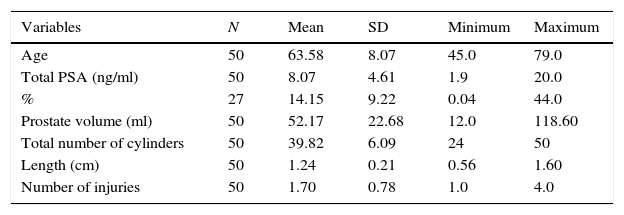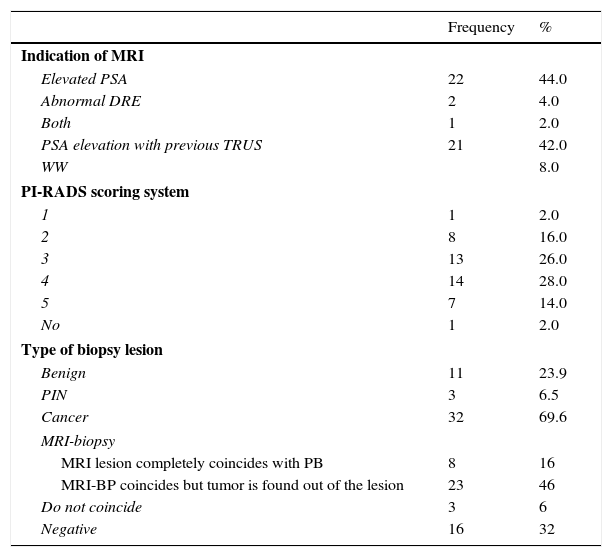The aim of this study is to present our initial experience with the stereotactic echo-MRI fusion system for diagnosing prostate cancer.
Material and methodsBetween September 2014 and January 2015, we performed 50 prostate biopsies using the stereotactic echo-MRI fusion system. The 3-Tesla multiparameter MR images were superimposed using this image fusion system on 3D echo images obtained with the Biopsee system for the exact locating of areas suspected of prostate cancer. The lesions were classified using the Prostate Imaging Report and Date System.
ResultsWe assessed a total of 50 patients, with a mean age of 63 years (range, 45–79), a mean prostate-specific antigen level of 8ng/ml (range, 1.9–20) and a mean prostate volume of 52ml (range, 12–118). Prostate cancer was diagnosed in 69% of the patients and intraepithelial neoplasia in 6%. The results of the biopsy were negative for 24% of the patients. The results of the biopsy and MRI were in agreement for 62% of the patients; however, 46% also had a tumor outside of the suspicious lesion. We diagnosed 46% anterior tumors and 33% apical tumors. One patient had a hematuria, another had a hematoma and a third had acute urine retention.
ConclusionsMultiparametric prostatic MRI helps identify prostate lesions suggestive of cancer. The Biopsee echo-MRI fusion system provides for guided biopsy and increases the diagnostic performance, reducing the false negatives of classical biopsies and increasing the diagnosis of anterior tumors. Transperineal access minimizes the risk of prostatic infection and sepsis.
El objetivo del estudio es presentar nuestra experiencia inicial con el sistema estereotáctico de fusión de imagen ECO-RM para el diagnóstico de cáncer de próstata.
Material y métodosEntre septiembre de 2014 y enero de 2015 se realizaron 50 biopsias de próstata mediante el sistema estereotáctico de fusión de imagen ECO-RM. Las imágenes de RM multiparaméticas 3Tesla (RM3T) se superpusieron mediante este sistema de fusión de imagen sobre las imágenes de ECO3D obtenidas con el sistema Biopsee para la localización exacta de las zonas de sospecha de cáncer de próstata. Las lesiones se clasificaron mediante el sistema Prostate Imaging Report and Data System.
ResultadosSe valoraron un total de 50 pacientes, edad media de 63 años (rango 45–79), PSA medio 8ng/ml (rango 1,9–20) y un volumen prostático medio de 52ml (rango 12–118). Se diagnosticó cáncer de próstata en el 69% de los pacientes, neoplasia intraepitelial (PIN) en el 6% y la biopsia resultó negativa en el 24%. Un 62% de los pacientes tenía coincidencia entre la biopsia y la RM, pero un 46% presentó tumor también fuera de la lesión sospechosa. Se diagnosticaron un 46% de tumores anteriores y un 33% de tumores apicales. Un paciente presentó hematuria, otro un hematoma y un tercero retención aguda de orina.
ConclusionesLa RM prostática multiparamétrica permite identificar lesiones de próstata sugestivas de cáncer. El sistema Biopsee de fusión de imagen ECO-RM permite su biopsia dirigida y aumenta el rendimiento diagnóstico, reduce los falsos negativos de las biopsias tradicionales y aumenta el diagnóstico de tumores anteriores. El acceso transperineal minimiza el riesgo de infección prostática o sepsis.
Artículo
Comprando el artículo el PDF del mismo podrá ser descargado
Precio 19,34 €
Comprar ahora











